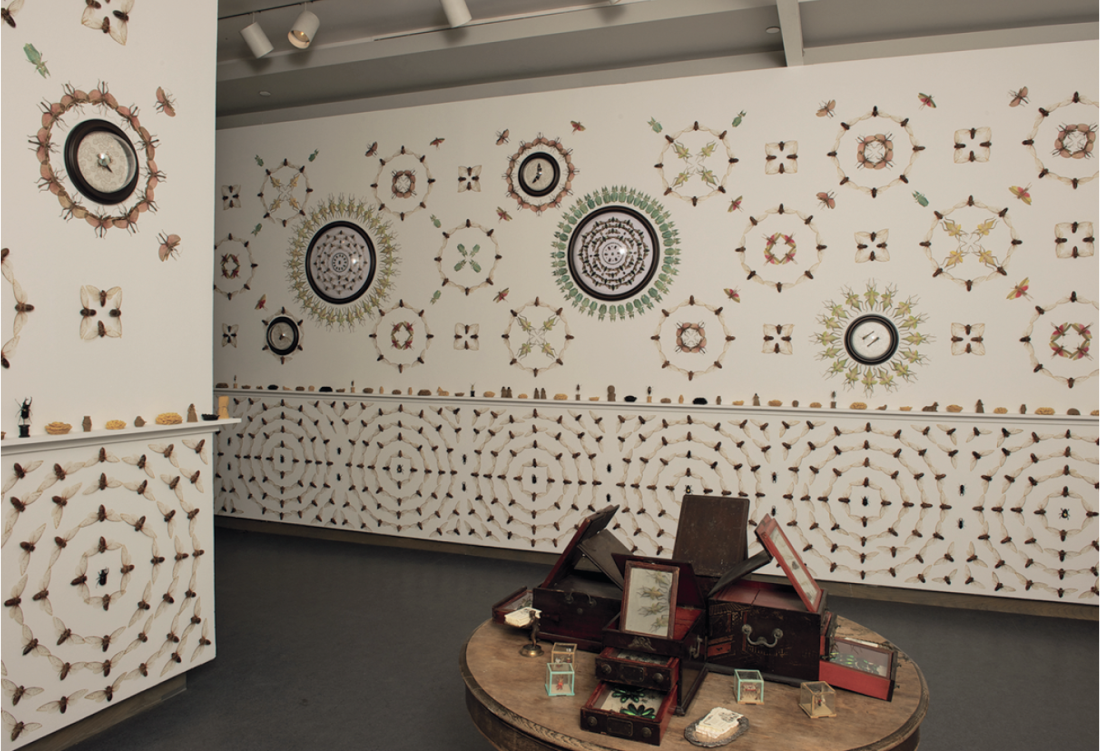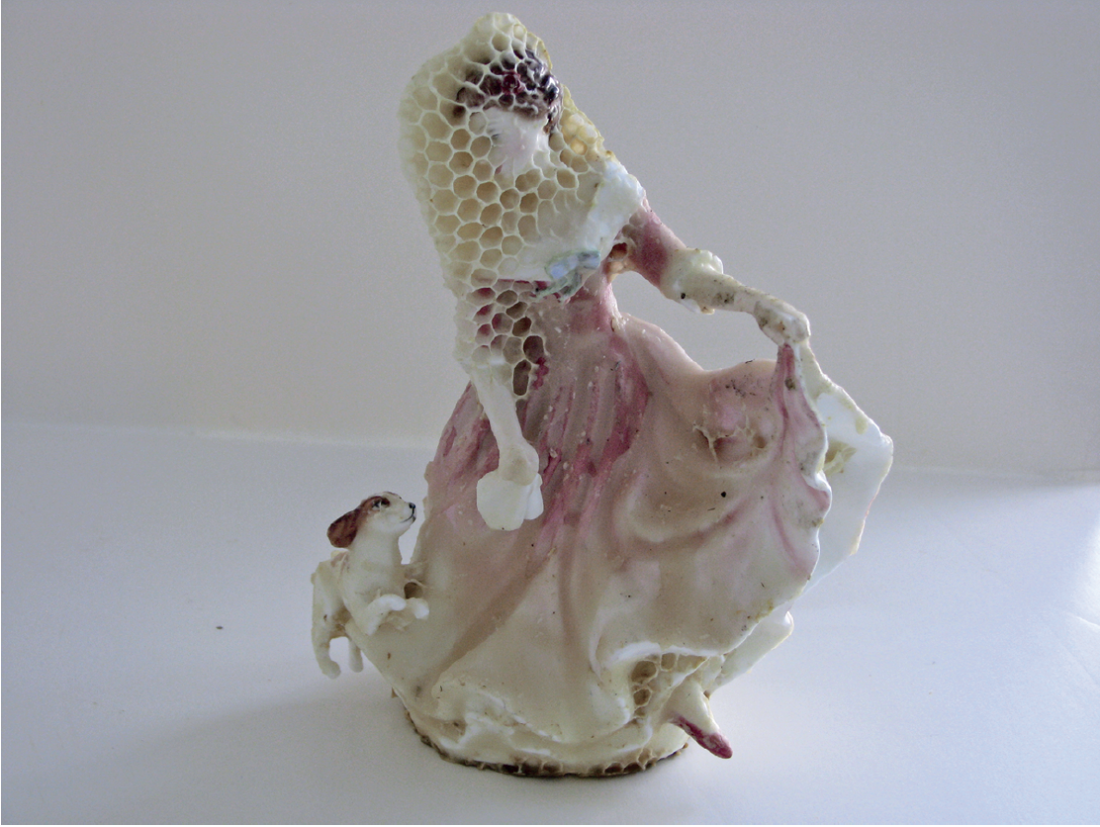“Exploded View”
In “Exploded View,” curated by Emily Falvey, five intrepid artists travel to the darker side of life to find beauty in its shadows. Along the way they shatter rational, categorized views of art, nature and culture. In one gallery, Howie Tsui’s convulsively drawn stream of horrific monsters faces Aganetha Dyck’s porcelain figures that are delicately laced with real honeycombs. In the other, Diana Thorneycroft’s unsettling close-up photographs of dolls’ mouths share space with Wim Delvoye’s photos of processed meat cleverly arranged to resemble marble floors. Jennifer R Angus has taken possession of the smallest gallery and adorned it with a collection of thousands of insects.
In this installation, Cryptozoology: An Exhibition of Mysterious and Unnatural Creatures, 2010, Angus pinned 2351 insects directly to the wall, creating patterns of breathtaking, intricate beauty using creatures that are more commonly appreciated in a squashed condition. Unbelievably large, bright-green beetles, once swarming in warmer climes where they were harvested for collectors, form circles with other insects, creating a Victorian-looking wallpaper. The installation is reminiscent of a centuries-old cabinet of curiosities: a wainscot ledge is covered with little wax figurines that incorporate insect body parts, a table displays tiny dioramas and stacks of pretty cards printed up with poems and lore on insects.
If Angus’s gallery makes us feel good about learning to appreciate the natural beauty of things that we usually find repugnant, Thorneycroft’s photographs provide no such release but leave us with an uneasy sense of appreciation. Her Doll Mouth Series, 2004–05, shows large blow-ups of the mouths of plastic dolls, children’s toys that the artist has collected over some time.

Jennifer R Angus, Cryptozoology: An Exhibition of Mysterious and Unnatural Creatures, 2010, mixed-media installation. Photograph: David Barbour. Courtesy the artist and the Ottawa Art Gallery.
Delvoye foils taboos somewhat by shifting his focus from the flesh of humans to the butcher shop. A series of four large photographs, “Marble Floors,” 1999, shows what appear to be inlaid floors in varied shades of pink that turn out to be slices of salami, tongue, boloney. More than one-liners, the pictures evoke a troubled sense of what people do to living things. Being aware that this well-known Belgian artist tattoos the skins of people and pigs alike brings to mind a transposition of humans and animals that lend to these works a whole other layer of horror.
The corporeal unease created in “Exploded View” finds much of its origins in the confusion of the organic and the inorganic that forms a veiled threat to the viewer’s sense of coherent identity: insect wallpaper, plastic turned sexual, floors made of meat. In this context, Delvoye’s Cement Truck, 2004, a large model of a Corten steel vehicle, seems slightly out of place. The truck is pierced with patterns of Gothic leaded windows, but the entanglement of machine and cathedral, though amusing and beautiful, has little bearing on the viewer’s embodied reality.
A meshing of the organic and inorganic returns with Dyck’s the MMasked Ball Series, 2008, porcelain figurines of graceful 18th-century ladies that are partly covered with honeycomb patterns created by bees. To achieve this wonderful collaboration with nature, Dyck simply placed the figures into the dark of the hive and let the bees do their work. By relinquishing some of her artistic skills and control to the insects, the artist questions a specific kind of autonomy, that of the artist/creator. The bees’ work could be considered a decoration of the artifacts, but at the same time it provokes an uneasy sense that this enhancement could turn into an overpowering takeover at any time.

Aganetha Dyck, The MMasked Ball Series, 2008, beework on figurine. Courtesy the artist and Michael Gibson Gallery, London, Ontario.
The sense of balance in hybridity that remains tentatively present in Dyck’s work is mostly lost in the fearful narratives of Tsui’s drawings. His grotesque figures, falling, drowning, melding and metamorphosing, are engaged in a struggle with themselves and others, as well as with their history and environment. Tsui has created a stream-of-consciousness wave of drawings on large scrolls in his Horror Fables, 2010, by mixing Asian folklore and religious tales, Eastern and Western Pop culture images. Of Shunga and Monsters, 2010, are small vignettes created from found “Shunga” images, erotic Japanese drawings painted over with the artist’s own fantastic monsters. His grotesque drawings tap into a shared human fear of injury, decay and death that has, over centuries, found a myriad of culture-specific expressions in myths and fairy tales. Such narratives can still provide metaphorical worlds in which to fight one’s demons.
The mutations and metamorphoses in this exhibition range from nightmarish to wondrous, but all retain a sense of tentativeness, of continuously evolving and always contingent identity formations. At the same time, they underscore a point that is easily forgotten in the slick special effects of horror films and computer games: the creation of a self requires an extensive individual effort. Countering a sense of image and identity diffraction that has become so acute in an age of endless reproduction, these idiosyncratic, hand-made works (even if the hand was aided by machinery or nature) convey a sense of individuality and integrity in the midst of flux. They address the viewer in an intimate, sentient way, creating an awareness of the I within a web of connections. ❚
“Exploded View” was exhibited at The Ottawa Art Gallery from February 25 to May 9, 2010.
Petra Halkes is a painter, art writer and curator living in Ottawa.

